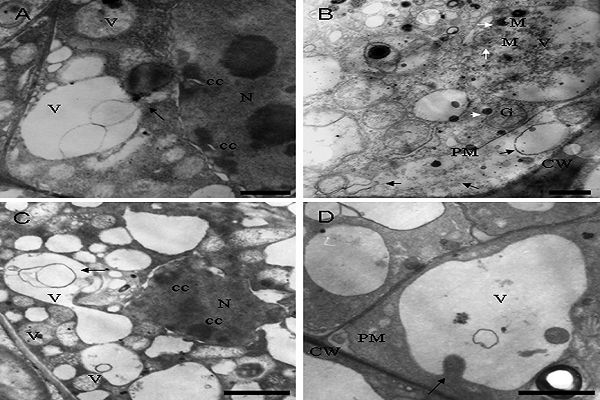Programmed cell death (PCD) is an active process of autophagy induced by a change in cellular homeostasis that usually requires protein synthesis and signal transduction. In animals, the most common form of PCD has been termed apoptosis. The hallmarks of apoptosis include chromatin condensation, internucleosomal DNA cleavage, membrane blebbing, the formation of apoptotic bodies and their engulfment by phagocytosis. PCD in plants is responsible for removal of redundant,misplaced, or damaged cells, which contributes significantly to both development and maintenance of these multicellular organisms.
Salt stress is one of the most serious problems in agriculture in arid and semi-arid areas (Katsuhara and Kawasaki, 1996). Possible mechanisms of salt-induced plant PCD have been elucidated previously.Thellungiella is a true halophyte and can survive for several months and produce viable seeds, even in the presence of 500mM NaCl.
The research of salt stress induces programmed cell death in Thellungiella halophile suspension-cultured cells was completed recently by the researchers of Cold and Arid Regions Environmental and Engineering Research Institute. Thellungiella halophila (T. halophila) suspension-cultured cells were used to gain knowledge of the pathway of programmed cell death (PCD) in halophytes under salt stress. Several apoptotic-like features occurred in T. halophila cells after exposure to 300mM NaCl, including the retraction of the plasma membrane from the cell wall, nuclear condensation, DNA laddering and the release of cytochrome c accompanying the increase of caspase 3-like protease activity. This process resulted in ultrastructural changes of mitochondria and Golgi bodies, and autophagy was also induced by high salinity stress.DNA laddering and caspase 3-like activity were inhibited prior to the inhibition of cell death by a specific caspase 3 inhibitor, Ac-DEVD-CHO. The results indicate that 300mM NaCl stress-induced PCD in T.halophila is similar to animal apoptosis, and this process occurs partly through a caspase 3-like dependent pathway.
The research was subsidized by the National Natural Science Foundation of China (Grant Nos. 40825001 and 30800122).

Ultrastructural features of 300mM NaCl stress-induced autophagy occurring at 6 h (A), 12 h (B), 16 h (C) and 24 h (D) in T. halophila suspension cells. Cytoplasm was
being engulfed into the vacuole in (A), (C) and (D) and arrows points to the site of autophagy. White arrows in (B) pointed at vacuoles containing cellular organelles and other
inclusion bodies. Particulate matter and irregularly shaped matter between the plasma membrane and the cell wall were observed (black arrows). V, vacuole; N, nucleus;
CW, cell wall; PM, plasma membrane; cc, chromatin condensation; G, Golgi body; M, mitochondria. Bar = 1m (A and C), 500nm (B) and 2m (D)(image by Journal of Plant Physiology)

